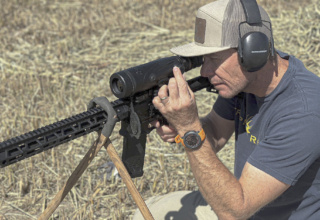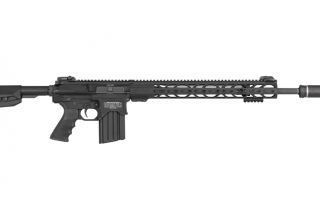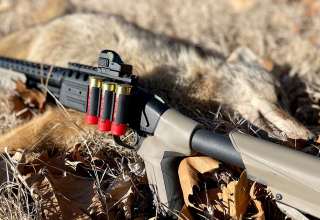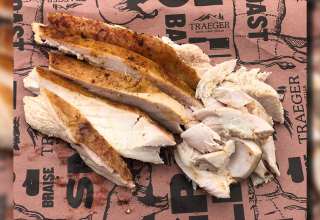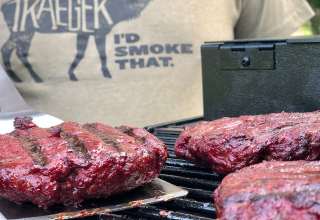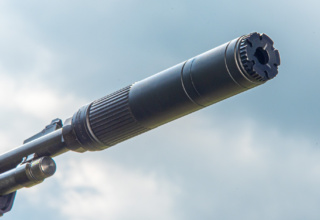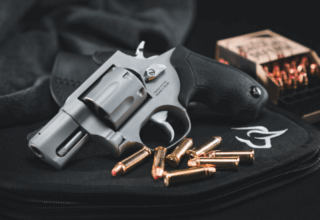While bowhunting whitetail deer last October, I found myself nestled in my treestand watching a field full of feeding deer. It was one of the first cool mornings of fall, frost was on the ground, a crisp cool breeze was blowing; Creating a great morning for deer movement. However, when I started thinking this could be the morning to see a mature buck, the tables turned. I watched all of the deer that had been feeding bounce out of the field, waving the warning flags with their white tails. Excitement went to confusion as I witnessed a large, woolly coyote trotting across the field. I tried lip squeaking him into bow range, but I couldn’t get his attention to break from the nearby deer. It’s mornings like this that remind me why I enjoy predator hunting.
As hunters/conservationists, one of the biggest tools in wildlife management is controlling predators. Coyotes are especially well-known as having a negative impact on a deer herd by taking out multiple fawns during the late spring and even having the ability to join together to take down a full-grown deer during the fall or winter. The simple fact is that when you have a high number of predators, it doesn’t take long to see a negative impact on the deer population. To make an effective impact on predators, one must make it a year round task.

When most people think about predator hunting they think of it taking place in January or February when it is cold. This cold weather sets coyotes into survival mode, they become very active in finding food to stay warm. Not to mention the increased activity caused by their breeding season – which usually takes place sometime within those first two months of the year as well. When it comes to hunting coyotes for deer management, the winter months are not the only time to be hunting. Late spring and throughout the summer are the best times for calling coyotes, when doing so as a deer management tool. Coyotes make it the hardest on whitetail deer when does are raising fawns. During this time coyotes are raising pups as well, which means coyotes are going to need extra food to be able to properly feed their young. This alone makes calling for coyotes this time of year so effective.
When calling coyotes during spring and summer, I take advantage of all of the different coyote vocals found on my FoxPro Shockwave electronic caller. Coyote Pair Howling, Fem Long Howls, and of course Pup Screams, as well as Coyote Pup Distress are all very effective sounds to use. A lot of my stands will start with some type of a Long Howl on my electronic call mixed with some howls from my diaphragm howler. After a minute or two, I will follow-up with Coyote Pups in distress. Doing this keys in on the parental instincts of the females as well as the curiosity instincts of other coyotes in the area. My next calling technique is to use distress sounds, as with deer and coyotes many other animals are having their young this time of year. This is why using fawn in distress and baby cottontail distress, which are both natural sounds, will bring coyotes in that are trying to find an easy meal.
[quotes quotes_style=”bquotes” quotes_pos=”center”]A good calling tip is to match your calls according to what is going on during that specific season[/quotes]
During the summer months of the year, I do most of my hunting near my home in southern Missouri. The terrain around this area is mostly open fields and cow pastures, so I hunt these areas because of the heavy foliage in wooded areas. This time of year can be challenging in choosing what weapon and ammo should be used. During the summer months, it’s great time to use a heavier caliber rifle compared to lighter more fur friendly loads that would typically be used during the winter months. I recently started using a Rock River Arms LAR-8 Predator HP in a .308 caliber. I chose to shoot a Hornady 168 gr. ELD Match bullet out of this deadly accurate gun. This combination is a perfect recipe for shooting through the tall summer grass that is commonly found in the hay fields or cow pastures. Smaller calibers such as a 22-250 have been known to veer off target when skimming across tall grass, which is the main reason for using larger calibers throughout the summer. Since most of summer time hunting is done in fields, choosing an AR 10 style gun such as the Rock River Arms Predator HP is also an excellent choice to get multiple accurate shots off when a coyote is moving through the open fields.
In conclusion, not only does hunting coyotes year round help to control the coyote population, it also helps sustain the population of deer. Anyone can help take part in this management plan simply by using a few key strategies, such as quality sounds that are common to the time of year, as well as being ready to make a deadly shot with quality shooting equipment that won’t slow you down.


